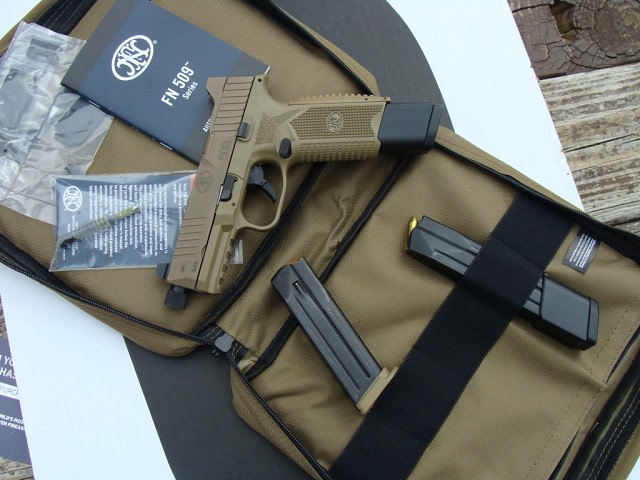
Curious about the FN 509 9mm tactical pistol? Well, I dropped by our agency’s range the other day, mostly for a visit with the firearms instructors. A multi-day pistol school was in progress and several makes of LE-type handguns were present.
by Steve Markwith, author of Handguns: A Buyer’s and Shooter’s Guide
It came as no surprise that they all shared a few common features including polymer frames with capacious mag-wells, adaptable grips, accessory rails, and striker-fired ignition systems. Of note, some were also configured to accept miniature red-dot (MRD) sights. Recognizing they’re the latest breaking wave, many of the established gun makers have finally jumped aboard with at least one optics-friendly offering. One feature absent that day though was a factory-threaded barrel. However, I did have a new FN 509 9mm tactical pistol on loan which managed to nail the whole list.
Many firearm aficionados are no doubt aware of the U.S. Military’s Modular Handgun System trials which sparked the development of several good submissions. Sig was declared the winner but, once the dust settled, FN’s entry lead to the 509 Tactical. As for FN, they’ve been a dominant civilian and military arms source since the late 1800s. Their Belgian roots have since spread and the present FN-H consortium is a serious global contender.
The 509 Tactical comes from FN America and it’s built in South Carolina. I can’t help but wonder if its designers decided to incorporate the best features from several tried and true pistols for the MHS program.
Unboxing the FN 509 9mm
The FN 509 here bears a flat dark earth (FDE) finish. The military wanted an active safety lever, but this one follows other striker-fired types which rely solely on a trigger-block. It ships in a nice soft case with three magazines, an extra recoil spring, a replacement back-strap, and a “low profile optics mounting system” that should accommodate most of today’s popular MRD offerings. Several mounting plates and their hardware are included with a chart to help sort out correct combinations. The lighter spare recoil spring includes information pertaining to use of milder loads or suppressors. Overall, the factory literature was very thorough.
My first impression was one of total commitment by FN to quality and user satisfaction. The pistol itself feels solid, and for me, it indexed right through the sights. The controls were also accessible for my medium-sized mitts, and being bilateral, they’ll work as well for lefties. Although both sides bore generous control pads I encountered no off-side interference.
Initial Impression
The FN 509 is a well-thought-out design intended for serious business. Of course, the proof is in the shooting. But before I fire it, I always enjoy a “peek under the hood.” Truthfully, if a firearm is a pain to disassemble our relationship will be short. Turned out, I wasn’t disappointed.
FN 509 Construction
Most of my FN experience involves the classic 9mm High-Power, otherwise known as the P-35 (the year when it appeared). I’ve always enjoyed shooting these steel-framed classics, in part because they’re so darn easy to field strip – especially compared to a Model 1911 (although both were conceived by John Browning).
Actually, Mr. Browning’s fingerprints are on this FN, along with legions of competing double-stack types that function via tilting breech barrels. Happily, disassembly of the FN 509 was simple, although the process had more in common with a polymer S&W M&P. Both employ a rotating take-down lever located on the frame’s left side ahead of the trigger guard.
Disassembly
The disassembly process starts for either by removing the magazine, clearing the chamber, and locking the slide open. S&W incorporates a small “tab-thingy” intended to lower the sear so the slide-mounted striker can pass over it. This precludes the need for a dry-fire.
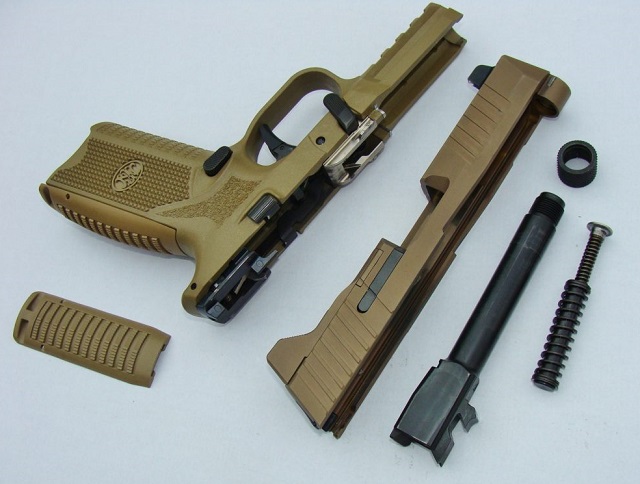
With the FN, the slide is maneuvered forward as if in battery, at which point it’ll need to be dry-fired like many other striker-fired pistols. Then, the slide assembly can be pulled forward off the frame. Removal of the recoil spring and barrel follows most other designs; however, because the 509’s muzzle has a protective knurled cap, it must be unscrewed before the barrel can be withdrawn from the slide.
Frame
The FDE color appears to be molded-in. More M&P could also be in the mix, along with a dash of 1911. I tend to reference M&Ps because we (my agency) inventory several hundred in 9mm and .40 S&W. The 509’s frame rails look a lot like those of our 1st gen M&Ps, which were two separate pinned units. Problems were few, but we did eventually encounter a couple cracked rails, both involving feisty .40 loads. At that point, a metal-frame pistol would be toast. Instead, the repair was as simple as replacing a rail insert.
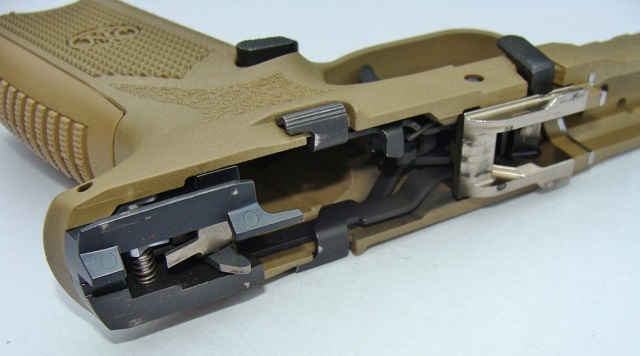
FN’s look plenty strong but are advertised as replaceable. If nothing else, it’s reassuring to know this option exists. The FN’s jointed trigger also looks M&P-ish with a lower half that pivots to retract a blocking tab. The serial number is embedded in the polymer frame’s integral 1.750” accessory rail, which has four slots. The checkering patterns are aggressive enough to provide plenty of grip purchase without chewing up hands or clothing.
The dash of 1911 is evident through the two back straps in arched and flat configurations. They slide up a vertical dovetail at the rear of the frame, and are retained by a pin. Each insert also has a lanyard hole. The mag-well has relief-depressions to help rip out a stubborn magazine. As noted above, the slide and magazine-release controls are bilateral and topped by generous pads.
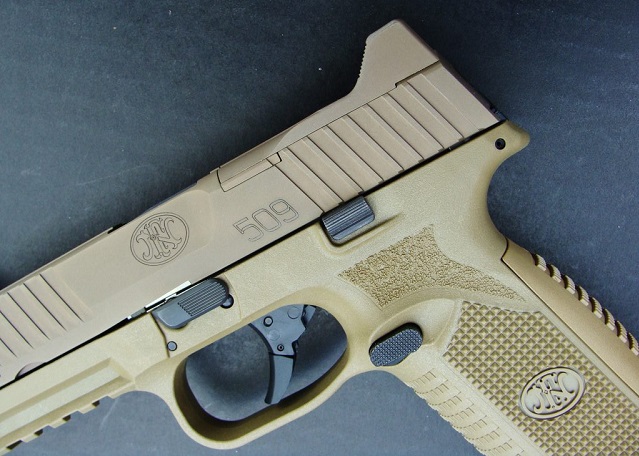
Magazines
Here’s where things get interesting. The base-plate of the standard 17-round version abuts the frame. It’s a steel unit stamped for the 9mm caliber, with numbered indicator holes. Captured by one forward-facing central lug, it free-falls when released. Nothing extraordinary with this one, but the other two will raise eyebrows when seated in the pistol. They protrude for good reason; 24 round capacity! Yup, with a chambered round, you get a half a box! However, this does affect the weight of the pistol (see below for more about that). Over-insertion is prevented by use of polymer spacers.
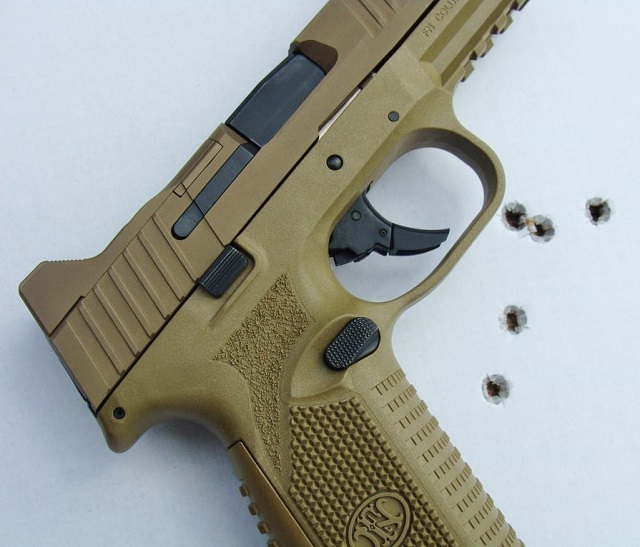
Slide Assembly
Possibly, the 509’s slide has a pinch of Springfield Armory XD. In any case, it’s less blocky than a Glock. Still, it’s a robust FDE/stainless unit with cocking serrations fore and aft. The extractor has plenty of bite and doubles as a loaded-chamber indicator. Visible underneath is the typical striker-blocking plunger, disengaged through depression of the trigger. The recoil spring is captive on the metal guide-rod during disassembly.
Sights
The sights are dovetailed (a good thing), and the rear nestles within a pair of rugged protective ears. Turns out the ears are part of the removable 1.950” filler-plate secured by two torx-screws. Unlike some other designs, the rear sight remains mounted to the slide. It, and the front sight, are rugged, but tall enough to clear most suppressors, or to co-witness through MRD optics. Both have Tritium inserts and the front element is a real eye-grabber. Its blade measures 0.125” and is easy to center in the fixed 0.150” rear notch.
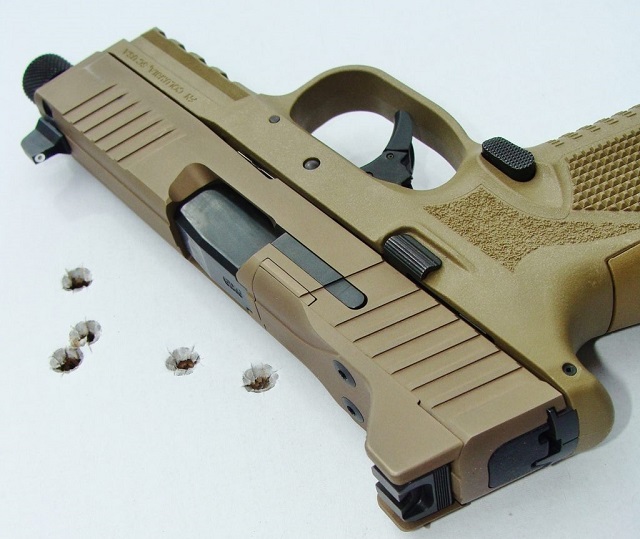
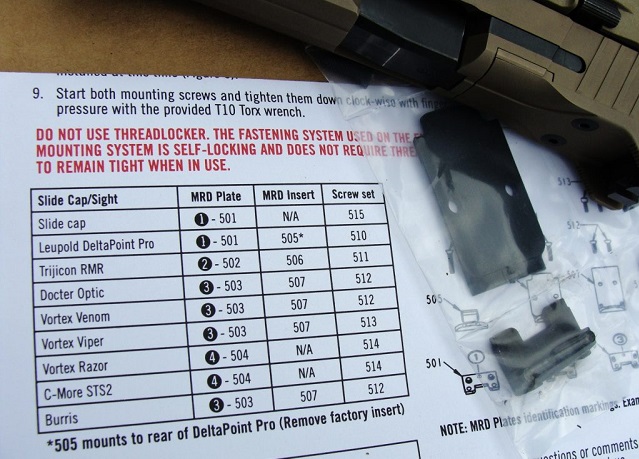
9mm Barrel
Like most of today’s other pistols, the 509 employs the strong breech/slide locking system popularized by Sig. Listed as stainless steel, the FN’s has a dark finish – except for the highly polished feed ramp. It measures 4.360” to the tip of the knurled collar that protects the 1/2×28 threaded muzzle section. The collar stays put thanks to the friction of its internal O-ring, but can be easily removed using fingers.
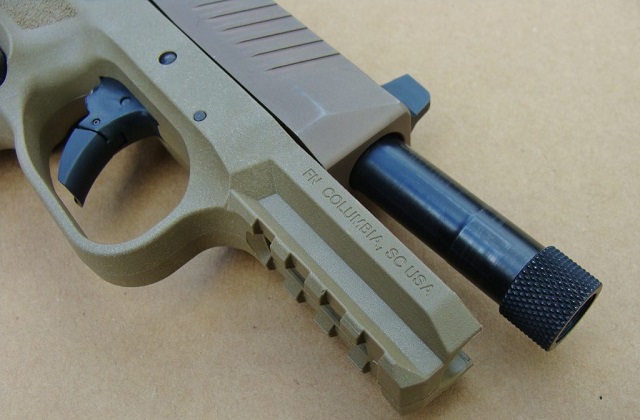
The 9mm bore is rifled conventionally with six grooves. The twist is 1:10, as it should be for predictable results with expanding bullets engineered to FBI protocols.
FN 509 Tactical Accuracy
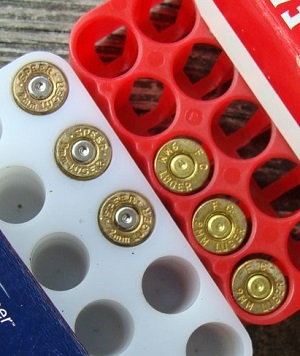
I wasn’t the least surprised when this 509 Tactical ran without a hitch. I did the majority of shooting with the 17-round magazine, firing from a two-handed ready (I didn’t want to risk scuffing up a loaner gun on an ill-fitting holster). I also fired groups off a rest to explore the 509’s accuracy potential at 25 yards.
All of my MRD sights were mounted on other guns so I stuck with the FN’s iron sights. Because this range session was amidst the height of the dreaded virus, I limited testing to just three high-confidence loads – types we buy by the pallet. This 9mm list included Speer 124 Gold Dot, Speer Lawman 124 TMJ, and Federal American Eagle 124 FMJ.
Function
The pistol ships with the heavier recoil spring installed. The spare spring is for use with suppressors or softer-recoiling loads (like frangibles that use lighter bullets). I stuck with the heavier spring and it worked, although Fed AEs were probably close to the edge. Some ejected cases bounced off my hat and one wound up in a boot.
Surprisingly, the pistol ate ‘em, even when fired with just the support hand. Examining some fired brass, primer indents were deep and round. Tear-drop dents can be a sign of premature unlocking (not to be confused with chisel-point strikers). When function proves dependable with a heavier spring, it’s easier on the gun. And, in this case, manual slide retraction wasn’t difficult.
Accuracy
Defensive ammo is expensive, so affordable practice rounds that shoot to the same point help. One load that usually delivers is Speer’s 124 Lawman TMJ, which can be purchased at Palmetto State Armory. It generally produces good accuracy. A series of five-shot, 25 yard groups, averaged a respectable 2 ¼-inches. The other loads performed similarly and, of equal importance, they all impacted right on top of the front sight.
Speaking of which, the sight picture struck a useful balance of boldness and precision. At just below seven pounds the trigger was a bit heavy, but it did have a tactile reset. Some people install aftermarket triggers in their striker-fired pistols that can approach three pounds, but that’s asking for trouble with a defensive handgun – especially one sans a separate safety mechanism.
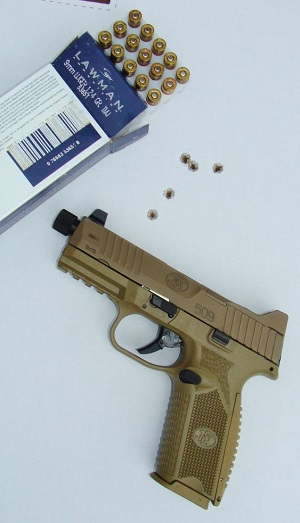
FN 509 Tactical Weight and Handling
The similarly configured Glock 17 Gen 4 MOS is listed at just under 25 ounces unloaded. The 509 Tactical is three ounces heavier, which may account for its solid feel. But, of course, weight and handling change substantially when lots of cartridges are stuffed inside a grip. I tried a few magazines loaded with only 5-rounds to evaluate recoil at the light end. Control was never a problem.
When fully loaded to 17 +1, the 509 was as manageable as most other 9mm polymer hi-cap wonders. But, the FN just squatted after a switch to the 24-rounders. Of course, as ammo is consumed, handling dynamics and recoil will change. Also, 24 +1 rounds of any 9mm will really tug on a hip (not to mention spare mags).
Common bullets run 115 – 147 grains and the heaviest add even more weight – especially in half-box quantities. Of course, true tactical operators have the gear and physique to manage such payloads, with the advantage of more rounds, but that ship has sailed for me. The 17-round magazines will at least keep me out of suspenders.
FN 509 Tactical Conclusion
The aptly named FN 509 Tactical does indeed exude a business-like quality. There may be sleeker pistols and, yes, the trigger was a bit heavy, but to my mind, this one’s built to fight. One example is the protective ears that surround the rear sight. Their front sloping edges are actually serrated for increased bite on a belt or other surface. This seemingly small detail could save the day if one-handed slide operation was ever necessary. It’s also a testament to experience in the defensive arena. In fact, FN has been supplying U.S. Military forces with firearms for some time now. Those with concerns about reliability in tough conditions could do worse than the 509. FN America lists it as described for $1049, but I’ve seen some for closer to $900 among the on-line gun sites.